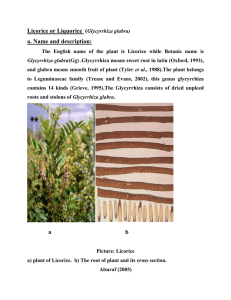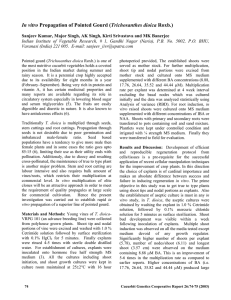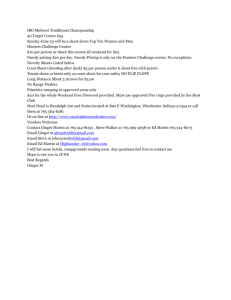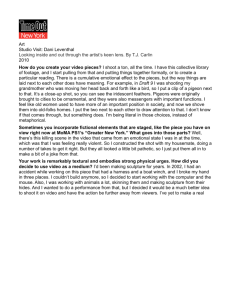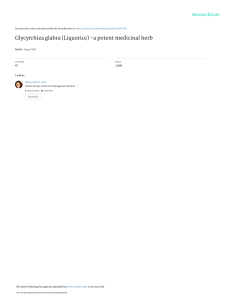Document 14258324
advertisement
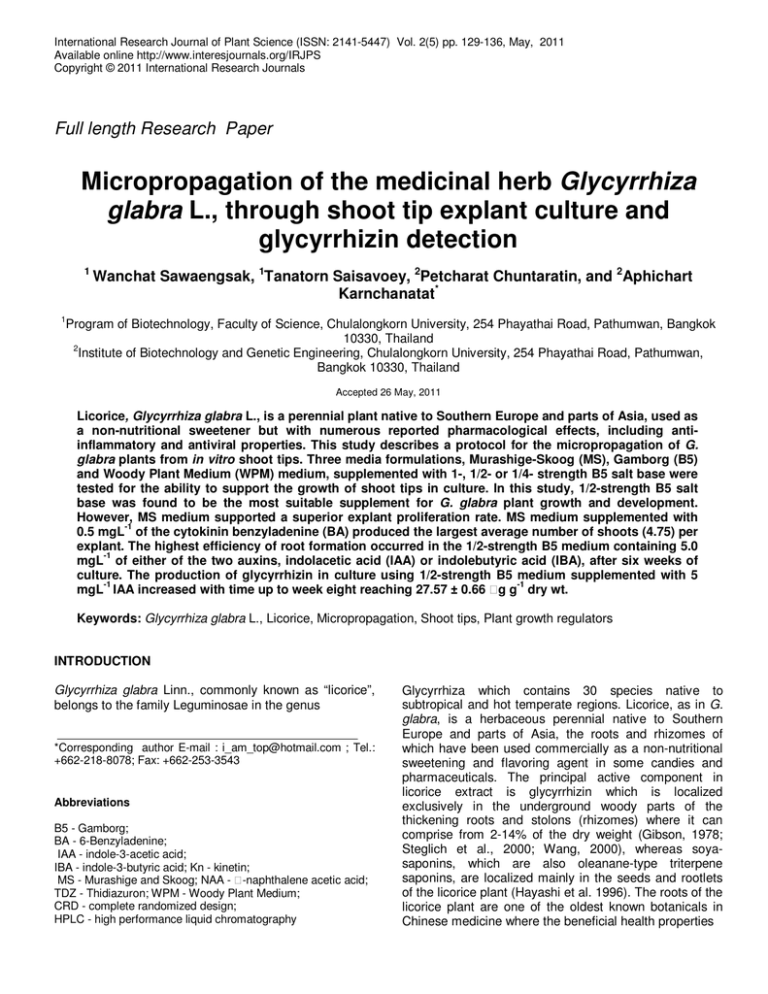
International Research Journal of Plant Science (ISSN: 2141-5447) Vol. 2(5) pp. 129-136, May, 2011 Available online http://www.interesjournals.org/IRJPS Copyright © 2011 International Research Journals Full length Research Paper Micropropagation of the medicinal herb Glycyrrhiza glabra L., through shoot tip explant culture and glycyrrhizin detection 1 Wanchat Sawaengsak, 1Tanatorn Saisavoey, 2Petcharat Chuntaratin, and 2Aphichart Karnchanatat* 1 Program of Biotechnology, Faculty of Science, Chulalongkorn University, 254 Phayathai Road, Pathumwan, Bangkok 10330, Thailand 2 Institute of Biotechnology and Genetic Engineering, Chulalongkorn University, 254 Phayathai Road, Pathumwan, Bangkok 10330, Thailand Accepted 26 May, 2011 Licorice, Glycyrrhiza glabra L., is a perennial plant native to Southern Europe and parts of Asia, used as a non-nutritional sweetener but with numerous reported pharmacological effects, including antiinflammatory and antiviral properties. This study describes a protocol for the micropropagation of G. glabra plants from in vitro shoot tips. Three media formulations, Murashige-Skoog (MS), Gamborg (B5) and Woody Plant Medium (WPM) medium, supplemented with 1-, 1/2- or 1/4- strength B5 salt base were tested for the ability to support the growth of shoot tips in culture. In this study, 1/2-strength B5 salt base was found to be the most suitable supplement for G. glabra plant growth and development. However, MS medium supported a superior explant proliferation rate. MS medium supplemented with 0.5 mgL-1 of the cytokinin benzyladenine (BA) produced the largest average number of shoots (4.75) per explant. The highest efficiency of root formation occurred in the 1/2-strength B5 medium containing 5.0 -1 mgL of either of the two auxins, indolacetic acid (IAA) or indolebutyric acid (IBA), after six weeks of culture. The production of glycyrrhizin in culture using 1/2-strength B5 medium supplemented with 5 mgL-1 IAA increased with time up to week eight reaching 27.57 ± 0.66 g g-1 dry wt. Keywords: Glycyrrhiza glabra L., Licorice, Micropropagation, Shoot tips, Plant growth regulators INTRODUCTION Glycyrrhiza glabra Linn., commonly known as “licorice”, belongs to the family Leguminosae in the genus *Corresponding author E-mail : i_am_top@hotmail.com ; Tel.: +662-218-8078; Fax: +662-253-3543 Abbreviations B5 - Gamborg; BA - 6-Benzyladenine; IAA - indole-3-acetic acid; IBA - indole-3-butyric acid; Kn - kinetin; MS - Murashige and Skoog; NAA - -naphthalene acetic acid; TDZ - Thidiazuron; WPM - Woody Plant Medium; CRD - complete randomized design; HPLC - high performance liquid chromatography Glycyrrhiza which contains 30 species native to subtropical and hot temperate regions. Licorice, as in G. glabra, is a herbaceous perennial native to Southern Europe and parts of Asia, the roots and rhizomes of which have been used commercially as a non-nutritional sweetening and flavoring agent in some candies and pharmaceuticals. The principal active component in licorice extract is glycyrrhizin which is localized exclusively in the underground woody parts of the thickening roots and stolons (rhizomes) where it can comprise from 2-14% of the dry weight (Gibson, 1978; Steglich et al., 2000; Wang, 2000), whereas soyasaponins, which are also oleanane-type triterpene saponins, are localized mainly in the seeds and rootlets of the licorice plant (Hayashi et al. 1996). The roots of the licorice plant are one of the oldest known botanicals in Chinese medicine where the beneficial health properties 130 Int. Res. J. Plant Sci. attributed to licorice include anti-inflammation, laxative, immunomodulatory, anti-ulcer, anti-allergy and anticarcinogenesis (He et al., 2001; Henry et al., 1991; Matsui et al., 2004; Takahara et al., 1994; Wang and Nixon, 2001). In addition, glycyrrhizin has anti-cancer, anti-bacterial, anti-spasmolytic and anti-viral activities, the latter against both DNA and RNA viruses (Fiore et al., 2008; Zalkov et al., 1994). In particular, it has been found to be highly active in inhibiting replication of the severe acute respiratory syndrome (SARS)-associated virus as well as a potential therapeutic agent for chronic hepatitis and acquired immunodeficiency syndrome (AIDS) (Baba et al., 1988; Cinatl et al., 2003; Ito et al., 1987). More than 400 compounds have been isolated from Glycyrrhiza species. Triterpene saponins and flavonoids are believed to be responsible for the bioactivities of licorice. The contents of these saponins and flavonoids may vary significantly due to different plant species and geographic sources (Zhang and Ye, 2009). Glycyrhizin is obtained from the roots and tubers of field grown intact plants, but the ability to grow the plant is restricted to certain climates only. In addition, the glycyrrhizin content may well vary with environmental changes, between seasons, soils and agricultural conditions, as well as between cultivar genetics. The qualitative analysis of G. glabra roots derived from different countries revealed that some phenolic compounds were indicative of the area of collection. Sample of licorice roots from Italy (51.91 mg/g) and China (53.26 mg/g) were the most rich in glycyrrhizin (Montoro et al., 2011). Although the quantitative of glycyrrhizin level related species and geographic sources, it could not keep the highest level of glycyrrhizin in uniformity. Even within the problem of these variations lies the more serious logistics of culture since the conventional method for propagation of G. glabra, a cross-pollinated plant, is of course via seed which restricts its multiplication and thus ease of economically viable agriculture. The alternative source, and one that offers the opportunity to overcome the poor seed germination problem, is in vitro culture which can provide a rapid propagation of new varieties within an economically viable timescale. To this end, Syrtanova and Mukhitdinova (1984) attempted the tissue culture based multiplication of G. glabra and G. uralensis from seedling cultures. Although multiple shoot formation with some 90 - 95% plantlet survival upon transplanting into the field has been reported (CIMAP, 2005), they gave no experimental details as to how this was attained. Meanwhile, the development of callus and cell cultures from G. glabra has increasingly been reported and included from shoot tips, roots, leaves, stems and hypocotyl as explant tissue sources (Hayashi et al., 1988; Hayashi et al., 1992; Henry et al., 1984; Tamaki et al., 1973; Yoo and Kim, 1986). Moreover, this has included the production of G. glabra plants from shoot tip and nodal explant cultures on simple minimal media (Kohjyouma et al., 1995; Thengane et al., 1998). Regenerative callus formation, as well as cell suspensions, have also been reported recently (Mousa et al., 2007). Given that plant cell cultures are a promising alternative source for the production of valuable secondary metabolites, this potentially paves the way for potential glycyrrhizin production in tissue culture. However, despite the initial reports on the successful tissue culture production of licorice explants, the ability to produce glycyrrhizin in cell culture is controversial. Initial reports of its production by Glycyrrhiza sp. callus and suspension cultures, including within larger scale 80 L airlift bioreactors, at levels approaching 3-4% of the dry weight (Scragg & Arias-Castro, 1992; Tamaki et al., 1973), were not replicated in callus or cell suspension cultures of a known G. glabra isolate (Hayashi et al., 1988). Likewise, although Ko et al. (1989) reported the production of glycyrrhizin in transformed hairy root cultures of G. ulalensis, they found no production in transformed roots of G. glabra. Nevertheless, the formation of glycyrrhizin in G. ulalensis calli cultured in a Murashige & Skoog (MS) based medium supplemented with auxin (either naphthalene acetic acid (NAA) or 2,4dichlorophenoxyacetic acid (2,4-D)) could be induced with specific combinations of the cytokinins benzyladenine (BA), 6-furfuryaminopurine (Kientin) or thiadiazuron (TDZ) (Shams-Ardakani et al., 2007; Wongwicha et al., 2008). Thus, in addition to variation in the genetic source (species and perhaps cultivars) of the tissue or cell suspension origins, the specific culture requirements including auxin / cytokinin concentrations or relative ratio, seem to be potentially important factors in glycyrrhizin production. To start to clarify this situation, this paper reports on a study which aimed to evaluate the optimal culture media and plant growth regulators on shoot multiplication and root induction for glycyrrhizin production by tissue culture techniques. MATERIALS AND METHODS Plant material and sterilization Shoots of G. glabra were taken from a single mature mother plant growing in the nursery of the Institute of Biotechnology and Genetic Engineering, Chulalongkorn University, Thailand. Shoot tips of 1.0 - 2.0 cm length were excised and rinsed for 30 min in running tap water, surface-sterilized for 15 min in 10% (v/v) Clorox containing 0.1% (v/v) Tween 20, and washed three times with sterile water. The sterilized shoot explants were then cultured individually on induction medium. Initiation of cultures and culture condition Sterilized shoot explants were cultured individually under aseptic conditions on MS (Murashige and Skoog, 1962) media containing 3.0% (w/v) sucrose as a carbon source and 0.7% (w/v) agar. The pH of the medium was adjusted to 5.7 using 1 N NaOH before autoclaving. The cultures were maintained at 25 ± Sawaengsak et al. 131 2 °C in the presence of 16/8 h (light/dark) photoperiod, with light provided by a cool-white fluorescent tube at an intensity of 55 -2 -1 mol m s . Effect of medium formulations and concentration on shoot growth and development To optimize the culture medium for the growth and development of shoots, the shoot tips of in vitro grown plantlets were evaluated after 1 month of culture in MS, B5 (Gamborg et al., 1968) or WPM (Lloyd and McCown, 1981) media. Each media was varied in the concentration of the salt base supplement using 1-, 1/2- or 1/4- strength concentrations (still maintaining a final concentration of 3.0% (w/v) sucrose in 0.7% (w/v) agar). The pH of each media was adjusted to 5.7, sterilized and plants cultured in it as described previously above. The number and length of the shoots, the stem diameter and leaf width were all recorded after six weeks of culture. 250 × 4.6 mm) by a stepwise gradient elution using a decreasing acetic acid (1% (v/v)) to acetonitrile (v/v) ratio mobile phase as follows: 0 min(90:10), 15 min (50:50), 40 min (40:60) and 50 min (0:100). The flow rate of the mobile phase was 0.9 ml/min with UV absorbance detection at 254 nm. For the time course study, untreated plants and those supplemented with plant growth regulators in the root media were harvested at 6, 8, 10 and 12 weeks. To observe the effect of root age in response to plant growth regulators, roots in different growth stages were treated with a specific amount of plant growth regulator. Glycyrrhizin content refers to the total amount of glycyrrhizin recovered from 0.1 g dry weight of root powder. Statistical analysis A complete randomized design (CRD) was used for all experiments. The data were analyzed using SPSS Version 16.0. ANOVA was used to analyze data. Significant differences were assessed using Scheffe’s multiple range test and significance was accepted at p< 0.05. Effect of cytokinin on shoot multiplication Shoot explants after four weeks of culture were cut transversely and transferred to the suitable medium (determined from the results of the above trails) supplemented with 3.0% (w/v) sucrose in 0.7% (w/v) agar, and supplemented with different concentrations (0-2.5 mgL-1) of one of the cytokinins, benzyladenine (BA), 6-Furfuryaminopurine (Kinetin) or thiadiazuron (TDZ). The transversely cut shoot explants were maintained in this culture for six weeks and then the number and length of shoots per plantlet were measured. Effect of auxin types on rooting ability To optimize root induction, in vitro shoot explants after four weeks of culture for 4 weeks were excised and transferred individually to medium supplemented with 3.0% (w/v) sucrose in 0.7% (w/v) agar containing different concentrations of auxins (05 mgL-1), being either IAA or IBA. The excised shoot explants were cultured for six weeks and then the number and length of the roots measured. Quantitative analysis The roots of licorice were dried at 50 °C to constant weight. A 100 mg aliquot of the dried sample was pulverized and then extracted with 20 ml of 95% methanol: water solution for 12 h before filtering and evaporating the filtrate to dryness to attain a crude glycyrrhizin preparation. The sample solution was prepared by dissolving the crude extract in 1 ml of 95% methanol: water solution and then a 10 l aliquot of this extract solution were analyzed by HPLC. The standard solutions were made up to volume with deionized water to give a series of standard solutions of 0.000, 0.025, 0.05, 0.1, 0.25, 0.5 and 1.0 mg/ml, used for the calibration curve. Deionized water, containing varying ratios of 1% (v/v) acetic acid: acetonitrile as the mobile phase. HPLC analysis was carried out on a ThermoFinningan HPLC Spectra System equipped with autosampler model AS3000, Photodiode array UV detector model UV6000LP and ChomQuest Software. The analysis was carried out on a Phenomenex column (Luna 5u C18(2) 100A, RESULTS AND DISCUSSION Shoots were found to be a suitable explant source for G. glabra micropropagation with a typical success rate in the in vitro tissue culture propagation of 90 - 95 % (range) in this study. After six weeks of culture, morphogenic changes in the cultured explants were clearly observed. The favorable effect of a low concentration of MS macronutrients, also noted in this study (data not shown), has been discussed by many authors, as has the increased rate of multiplication when using MS salts at 3/4-, 1/2- and 1/4- strength (Hyndman et al., 1982; George and Sherrington, 1984). In the present study, however, media formulation additionally was observed to display a clear effect upon the morphogenic responses that were observed. Overall, 1/2-strength B5 salts were the most suitable media for the in vitro tissue culture growth and morphogenesis of G. glabra plants (Table 1). The shoots were healthier and more uniform in length (Figure 1A) compared to those grown on other media (data not shown). However, despite the general beneficial effect of the reduced macronutrient level of media on G. glabra plant growth and differentiation (Table 1), the maximum number of shoots per explant (1.5) was found when explants were grown on full-strength MS salts, although this was only marginally higher than that on halfstrength MS. Therefore, the effect of cytokinins at different concentrations upon shoot multiplication rates was evaluated in explants cultured in full-strength MS salts. Certainly, the in vitro multiplication of G. glabra using different explants sources on modified MS media has been reported previously for seedling explants (Shah and Dalai, 1980) and cultures (Syrtanova and Mukhitdinova, 1984), as well as a high frequency regeneration of G. glabra from nodal explants (CIMAP, 1995). Moreover, whilst successful shoot tip explant cultivation in simple 132 Int. Res. J. Plant Sci. Table 1. Effect of different media on the morphogenic responses of shoot explants of G. glabra after six weeks of in vitro tissue culture. Data are shown as the mean ± 1 S.E. and are derived from 20 replicates. Means with different superscript lower case letters within a column are significantly different (p<0.05; Scheffe’s multiple means test). Media Strength Number of shoot/explant MS 1 1/2 1/4 1.50 ± 0.20 1.45 ± 0.21A A 1.10 ± 0.07 B5 1 1/2 1/4 1.40 ± 0.15 AB 1.25 ± 0.12 B 1.00 ± 0.00 WPM 1 1/2 1/4 1.00 ± 000 A 1.05 ± 0.05 1.00 ± 0.00A A A A Shoot length (cm) A 5.45 ± 0.40 5.80 ± 0.42A A 5.00 ± 0.30 B 5.00 ± 0.27 A 6.58 ± 0.32 AB 5.94 ± 0.38 B 5.12 ± 0.35 AB 6.30 ± 0.30 6.48 ± 0.35A media has been reported before (Thengane et al., 1998) study, however, shoot explants were successfully cultured for six weeks on MS medium, and that supplemented with 0.5 mgL-1 BA was found to be the most effective media (Figure 1B), attaining not only the highest number of shoots per explant but also the highest shoot length (Figure 2A and 2B). This is in agreement with previous reports that a low cytokinin concentration without any exogenously added auxins plays an important role in shoot induction (Kohjyouma et al., 1995; Thengane et al., 1998). Therefore, media supplemented with the cytokinin BA at 0.5 mgL-1 was selected as the appropriate condition for shoot proliferation assays in the following experiment. For the evaluating root induction, shoots of >1.0 cm long were excised and transferred individually to half-strength B5 salts supplemented with various concentrations (0 -1 5.0 mgL ) of either IAA or IBA. The highest frequency of root formation was obtained on the medium supplemented with 5.0 mgL-1 of either IAA or IBA (Figure 1C and 1D). However, whilst the addition of IBA in the rooting medium for explants was found to be more suitable for root induction than IAA containing medium in terms of the root length attained (Figure 3B), in contrast the addition of IAA yielded a greater ratio of explants that actually rooted than that seen with IBA (Figure 3A). The in vitro raised plantlets were subsequently transferred individually to plastic cups filled with sterile garden soil (SC1), vermiculite (SC2), garden soil mixed with vermiculite and ash husk at 1:1:1 (w/w) (SC3), ash husk (SC4) and garden soil mixed with ash husk at 1:1 (w/w) (SC5). These plantlets were kept at room temperature in natural light for about a week and then transferred to a greenhouse, where the surviving plantlets resumed Stem diameter (cm) Leaf width (cm) Number of branches/explant A 0.36 ± 0.02 0.32 ± 0.03B A 0.54 ± 0.02 A 0.60 ± 0.02 A 0.68 ± 0.03 B 0.54 ± 0.03 0.05 ± 0.03 0.05 ± 0.02A A 0.06 ± 0.02 0.07 ± 0.00 A 0.06 ± 0.00 B 0.05 ± 0.00 A 0.06 ± 0.00 B 0.05 ± 0.00 0.04 ± 0.00C B B 4.95 ± 0.21 5.95 ± 0.35AB A 6.35 ± 0.22 AB 6.30 ± 0.26 A 8.00 ± 0.33 A 7.35 ± 0.25 AB 3.55 ± 0.48 AB 4.85 ± 0.36 5.90 ± 0.24A 0.43 ± 0.03 A 0.49 ± 0.02 0.38 ± 0.02B B B normal growth and developed healthy leaves after two weeks. In the case of the SC1 media, some 95% of the plantlets survived (Figure 1E). At this stage the contents of glycyrrhizin were then analyzed by HPLC. The time course of the effect of the plant growth regulators on glycyrrhizin accumulation in 12-week-old cultures is shown in Figure 4. The maximum glycyrrhizin content (27.57 ± 0.66 g g-1 dry wt), attained after eight weeks in culture, was observed in plantlets cultured using 1/2-strength B5 medium supplemented with 5 mgL-1 IAA. Indeed, this glycyrrhizin level was very similar to that reported in G. uralensis calli cultured in MS media after induction with NAA and BA, but somewhat less than when induced with TDZ alone (~36.5 + 2.5 g g-1 dry wt) (Wongwicha et al., 2008). Until recently, previous work has reported the failure to detect in vitro production of glycyrrhizin in G. glabra L. (Wu et al., 1974; Hayashi et al., 1988; Henry et al., 1984), although they were found to contain several triterpenes. Indeed, although Ko et al. (1989) reported the production of glycyrrhizin in transformed hairy root cultures of G. ulalensis, they found no production in transformed roots of G. glabra. Wongwicha et al. (2008) recently reported that G. ulalensis calli induced using MS + NAA and BA or TDZ alone produced glycyrrhizin, as discussed above. However, Shams-Ardakani et al. (2007) similarly reported the formation of glycyrrhizin from G. glabra var. glandulifera calli tissue induced using MS + 2,4-D or NAA + 2,4-D + kinetin. This reported glycyrrhizin production in G. glabra, as opposed to G. ulalensis, is supported by this study reported here, but furthermore the production of glycyrrhizin from G. glabra shoot explants attained both a high level and also was observed changed as the concentration of plant growth regulator hormone, used to Sawaengsak et al. 133 Figure 1. G. glabra explants after culture in different media for six weeks. (A) Shoot explants of licorice on 1/2-strength B5 media; (B) Shoot multiplication of explants cultured on MS + 0.5 mgL-1BA; (C & D) rooted plantlets on 1/2-strength B5 salt media supplemented with 5.0 mgL-1of either (C) IAA or (D) IBA, and (E) three week old in vitro raised plantlets of G. glabra after transfer to a plastic bag containing SC1, SC2, SC3, SC4 and SC5. Bar = 1 cm. Figure 2. Effect of different concentrations of the three cytokinins, BA, Kinetin and TDZ, as supplements in MS media) on the average (A) number of shoots produced per explant and (B) shoot length, of G. glabra shoot explants, after in vitro culture for six weeks. Data are shown as the mean + 1 SE, and are derived from 20 replicates. Means with different lower case letters differ significantly (p< 0.05; Scheffe’s multiple range test). 134 Int. Res. J. Plant Sci. Figure 3. Effect of different concentrations of the two auxins, IAA and IBA, as supplements in half-strength B5 salt media on the average (A) ratio (%) of explants that rooted and (B) root length, of G. glabra shoot explants after in vitro culture for six weeks. Data are shown as the mean + 1 SE, and are derived from 20 replicates. Means with different lower case letters differ significantly (p< 0.05; Scheffe’s multiple range test). Figure 4. Time course of glycyrrhizin accumulation in G. glabra shoot explant cultures grown in vitro in 1/2-strength B5 salt media supplemented or not with either IAA or IBA at 5 mgL-1. Data are shown as the mean + 1 SE, and are derived from 20 replicates. Means with different lower case letters differ significantl y (p< 0.05; Scheffe’s multiple range test). Sawaengsak et al. 135 give a chemical stress to the explants at different growth stages, also changed. Indeed, the variation in the glycyrrhizin content was clearly attributed to the type and concentration of the plant growth regulator (auxin or cytokinin or the auxin/cytokinin ratio) used, which dramatically altered both the growth of explants and their glycyrrhizin formation in plant tissue culture. This is potential dependence upon the auxin/cytokinin ratio reported here in accord with the broad trend also observed for tissue culture of G. ulalensis explants (Wongwicha et al. 2008). In addition, the time course for glycyrrhizin accumulation in the cultured explants varied significantly, presumably reflecting large differences in glycyrrhizin formation during tissue development and differentiation. CONCLUSIONS A simple minimal medium of MS or B5 suitable for the in vitro tissue culture based growth and development of G. glabra shoot explants was developed. A high frequency of multiple shoots was accomplished on MS media supplemented with 0.5 mgL-1 BA. In addition, when supplemented with 5 mgL-1 IAA, the media was effective not only for root induction but also for glycyrrhizin formation, attaining the highest glycyrrhizin content after eight weeks. Using this procedure has the potential then to not regenerate plants on a large scale in a short time, but also to produce relatively high glycyrrhizin contents at the same time. This protocol will thus serve as a basis to enable future research into developing G. glabra transformed root cultures for the mass production of glycyrrhizin. ACKNOWLEDGMENTS The authors thank the Chulalongkorn University Graduate School thesis grant, the National Research University Project of CHE, the Ratchadaphiseksomphot Endowment Fund (AG001B, AM1019A, and AS613A), and the Thai Government Stimulus Package 2 (TKK2555), for financial support of this research, as well as the Institute of Biotechnology and Genetic Engineering for support and facilities. We also, thank Dr. Robert Butcher (Publication Counseling Unit, Chulalongkorn University) for his constructive comments in preparing this manuscript. REFERENCES Baba M, De Cleroq S, Nakashima H, Yamamoto N (1988). Mechanism of inhibitory effect of glycyrrhizin on replication of human immunodeficiency virus (HIV). Antiviral Res. 10: 289-298. Cinatl J, Morgenstern B, Bauer G, Chandra P, Rabenau H, Doerr, HW (2003). Glycyrrhizin, an active component of liquorice roots, and replication of (SARS)-associated coronavirus. Lancet. 2045-2046. CIMAP Newsletter In vitro propagation of licorice through multiple shoot formation. (1995). 21(4): 4-5. Dimitrova D, Verbanova K, Peeva I (1994). A study on in vitro cultivation of Glycyrrhiza glabra. Genetic resources newsletter. 12-13. Fiore C, Eisenhut M, Krausse R, Ragazzi E, Pellati D, Armanini D, Bielenberg J (2008). Antiviral effects of Glycyrrhiza species. Phytother. Res. 22: 141-148. Gamborg OL, Miller RA, Ojima K (1968). Nutrient requirements of suspension cultures of soybean root cells. Exp. Cell Res. 50: 151158. George EF, Sherrington PD (1984) Plant propagation by tissue culture: handbook and directory of commercial laboratories. Eversley, U.K.: Exegetics Ltd. VIII+709 pp. Gibson MR (1978) Glycyrrhiza in old and new perspectives. Lloydia 41: 348-354. Hayashi H, Fukui H, Tabata M (1988) Examination of triterpenoids produced by callus and cell suspension cultures of Glycyrrhiza glabra. Plant Cell 7: 508-511. Hayashi H, Yamada K, Fukui H, Tabata M (1992). Metabolism of exogenous 18 beta-glycyrrhetinic acid in cultured cells of Glycyrrhiza glabra. Phytochem. 31: 2729-2733. Hayashi H, Hiraoka N, Ikeshiro Y, Yamamoto H (1996). Organ specific localization of flavonoids in Glycyrrhiza glabra L. Plant Sci. 116: 233238. He JX, Akao T, Nishino T, Tan T (2001). The influence of commonly prescribed synthetic drugs for peptide ulcer on the pharmacokinetic fate of glycyrrhizin from Shaoyao-Gancao-tang. Biol. Pharm. Bull. 24: 1395-1399. Henry M, Edy AM, Marty B (1984). Isolation of licorice protoplasts (Glycyrrhiza glabra var. typica reg.et led) from cell-suspension cultures not producing glycyrrhetinic acid. Comptes rendus Serie 3: 899-903. Henry M, Edy AM, Desmarest P, Du Manoir J (1991). Glycyrrhiza glabra L. (licorice): cell culture, regeneration and production of glycyrrhizine. In: Bajaj, Y.P.S., ed. Biotechnology in agriculture and forestry, medicinal and aromatic plants III. Berlin: Springer-Verlag: 270-282. Hyndman SE, Hasegawa PM, Bressan RA (1982). Stimulation of root initiation from cultured rose shoots through the use of reduced concentrations of mineral salts. HortScience 17: 82-83. Ito M, Nakashima H, Baba M, Pauwels R, De Clercq E, Shigeta S, Yamamoto N (1987). Inhibitory effect of glycyrrhizin on the in vitro infectivity and cytopathic activity of the human immunodeficiency virus [HIV(HTLV-III/LAV)]. Antiviral Res. 7: 127-137. Kohjyouma M, Kohda H, Tani N, Ashida K, Sugino M, Yamamoto A, Horikoshi T (1995). In vitro Propagation from Axillary Buds of Glycyrrhiza glabra L. Plant Tiss. Cult. Lett. 12: 145-149. Ko KS, Noguchi H, Ebizuka Y, Sankawa U (1989). Oligoside production by hair root cultures transformed by Ri plasmids. Chem. Pharm. Bull. 37: 245-248. Lloyd GB, McCown BH (1981). Commercially feasible micropropagation of mountain laurel (Kalmia latifolia) by use of shoot tip culture. Comb. Proc. Int. Plant Prop. Soc. 30: 421-427. Matsui S, Matsumoto H, Sonoda Y, Ando K, Aizu-Yokota E, Sato T, Kasahara T (2004). Glycyrrhizin and related compounds downregulate production of inflammatory chemokines IL-8 and eotaxin 1 in a human lung fibroblast cell line. Int. Immunopharmacol. 4: 1633-1644. Montoro P, Maldini M, Russo M, Postorino S, Piacente S, Pizza C (2011). Metabolic profiling of roots of liquorice (Glycyrrhiza glabra) from different geographical area by EMI/MS/MS and determination of major metabolites by LC-ESI/MA and LC-ESI/MS/MS. J. Pharm. Biomed. Anal. 54: 535-544 Mousa NA, Siaguru P, Wiryowidago S, Wagih ME (2007). Establishment of regenerative callus and cell suspension system of licorice (Glycyrrhiza glabra) for the production of the sweetener glycyrrhizin in vitro. Sugar Tech. 9: 72-82. Murashige T, Skoog F (1962). A revised medium for rapid growth and bioassays with tobacco tissue culture. Physiol. Plantarum. 15: 417473. Scragg AH, Arias-Castro C (1992). Bioreactors for industrial production of flavors: use of plant cells. In: Biotransformation of flavors: 131-154. Shah RR, Dalai KC (1980). In vitro multiplication of Glycyrrhiza. Curr. 136 Int. Res. J. Plant Sci. Sci. (Bangalore). 49: 69-71. Shams-Ardakani M, Mohagheghzadeh A, Ghannadi A, Barati A (2007). Formation of glycyrrhizin by in vitro cultures of Glycyrrhiza glabra. Chem. Nat. Comp. 43: 353-354. Steglich W, Fugmann B, Lang-Fugmann SS (2000). Rompp encylopedia of natural products. Dunmur R. (translator). Thieme, Stuttgart: 269. Syrtanova GA, Mukhitdinova ZR (1984). Clonal multiplication attempts of Glycyrrhiza glabra L. and of Glycyrrhiza uralensis on culture media. Rastitel’ nye Resursy. 1: 85-88. Takahara T, Watanabe A, Shiraki K (1994). Effects of glycyrrhizin on hepatitis B surface antigen. A biomedical and morphological study. J. Hepatol. 21: 601-609. Tamaki E, Morishita I, Nishida K, Kato K, Matsumoto T (1973). Process for preparing licorice extract-like material for tobacco flavouring. US Patent. no. 3: 710, 512. Thengane SR, Kulkarni DK, Krishnamurthy KV (1998). Micropropagation of licorice (Glycyrrhiza glabra L.) through shoot tip and nodal cultures. In Vitro Cell Dev.-Pl. 34: 331-334. Wang ZY, Athar M, Bickers DR (2000). Licorice in foods and herbal drugs: Chemistry, pharmacology, toxicology and uses. In Herbs, botanicals&Teas, Mezza G, Oomah BD(eds). Technomic publishing Co. Inc: Lancaster, PA: 321-353. Wang ZY, Nixon DW (2001). Licorice and cancer. Nutr. Cancer. 39: 111. Wongwicha W, Tanaka H, Shoyama Y, Tuvshintogtokh I, Putalun W (2008). Production of glycyrrhizin in callus cultures of licorice. Z. Naturforsch. 63c: 413-417. Wu CH, Zabawa EM, Townsley PM (1974). The single cell suspension culture of the licorice plant Glycyrrhiza glabra. Can. Inst. Food Sci. Technol. J. 7: 105-107. Yoo SH, Kim SS (1986). Studies in tissue culture of medicinal plants (II). Tissue culture of Glycyrrhiza glabra L. var. glandufera. Reg. Et Herder. Korean J. Physiol. Pharmacol. 7: 55-57. Zalkov LH, Hudson CC, Powis G (1994). Mechanism based natural product anticancer drug discovery. ASOMPS VIII Malaysia.: 94. Zhang Q, Ye M (2009). Chemical analysis of the Chinese herbal medicine Gan-Cao (licorice), J. Chromatogr. A. 1216: 1954-1969.
